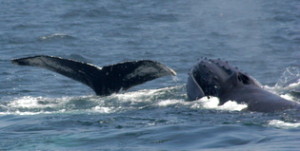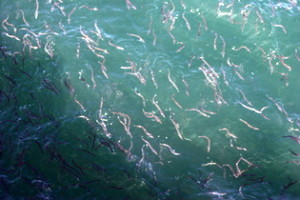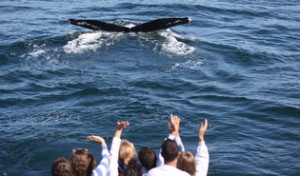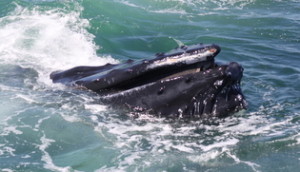Dolphin Fleet Naturalist Notebook – 7 August to 13 August
On August 7, our naturalist, Gwen, writes, “A beautiful, sunny, crisp day with perfect visibility! We saw one harbor seal as we rounded Long Point, which provided a nice start to the trip. Today we found ourselves just northeast of the triangle and spent time with two groups of whales. the first group consisted of Alphorn, Pele, Canopy and Bolide, while the second group was made up of Cajun and the calf, Milkweed and Jabiru.
“In the afternoon, there was much more wind. We ended up in the same spot as this morning. We started with two fin whales, then finished with the same two groups of whales as the morning. Although there were mostly deep dives, we did see a few breaches!”
August 8th was another bright sunny day filled with many sightings of humpback whales. At the beginning of the season we could barely go a day without spotting Whisk and her calf. Throughout July, however, the pair seemed to have explored different areas of the feeding ground, and today was the first time she was spotted in several weeks.
Humpbacks tend to return the same feeding grounds year after year, but these feeding grounds can be hundreds of square miles in size, so they may explore all corners of an area within a season. Additionally, humans and whales do not always have the same idea of what constitutes a feeding area boundary, and often whales will surprise us by leaving an area that we expect them to stay within.
Other whales spotted today included Jabiru, Pepper, Canopy, and Ventisca, and Doric, who has unusual white pigmentation on its dorsal fluke.
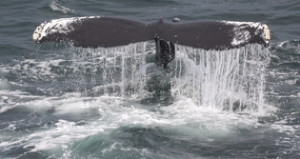
By August 9th, the large group of humpbacks east of Stellwagen Bank had grown to at least 20-25 animals, and in the morning, they had all started to feed! As far as we could see, we saw these large animals kick-feeding, using their huge tails to concentrate and aggregate their prey. After smacking the water with their flukes, they would lunge through the huge schools of sand lance, engulfing hundreds of gallons of food with every mouthful.
This morning, they were even joined by a huge pod of at least 150 Atlantic white-sided dolphins, who had clearly been attracted to the area for its huge amount of food!
By the afternoon, the wind picked up and although the feeding subsided, the high winds seemed to rile the whales up, and we saw several huge breaches!
On August 10 we headed back to the triangle to see if we could find the same bunch of whales. They had spread out but were still extremely active. We could see one humpback for miles before our arrival on the scene due to its exuberant surface behavior. It was breaching and splashing, as a second humpback swam along side. When we arrived, we noted that it was a humpback named Apex, distinguished by its triangular dorsal fin. Soon after we slowed down, this whale calmed down and stopped the splashing and breaching, but by that time, all of the passengers had gotten a chance to see this exciting behavior!
On August 11th we experienced an amazing feeding frenzy in the Triangle, an area to the east of Stellwagen Bank. Somewhere between 25 and 30 humpback whales had located an enormous school of fish, and they spent the morning kick feeding and blowing bubble rings to corral these fish into tight schools, lunging through them, and swallowing them whole.
Because of the maneuverability afforded to them by their long flippers, humpback whales can feed on a wide variety of small fish and krill. In Stellwagen Bank, however, their primary food source is the sand lance, a small schooling fish that is often used for bait. Today, huge schools of these fish could be seen wriggling and jumping at the surface. No wonder there were so many whales here!
Although much of the surface feeding had subsided by August 12th, there were still a few dozen humpback whales present east of Stellwagen Bank. We suspected that the food source had moved to the ocean floor, as the humpbacks appeared to be taking longer than average dives. That didn’t stop us from getting excellent looks at humpbacks as they rose from the depths to take a breath. Some of them fluked right off the bow of the boat!
Also in the area were between 100 and 200 Atlantic white-sided dolphins. The dolphins were milling around, not traveling, but rather swimming around in multiple directions, sometimes right around the humpbacks!
By the end of the week, on August 13th, the feeding had started back up again. We arrived in the triangle just as a single humpback was beginning to make the beginning of motions of kick-feeding. It lightly flicked its tail and began circling around a set spot. Pretty soon, this whale was kicking frantically and emerging through the frothy water with a bit mouthful of food. A few minutes later, we watched as other humpbacks began to book it towards the area at high speeds. Soon, we had humpbacks all around us, all kicking and blowing bubbles and feasting away on the small fish in the area.
By the afternoon, the humpbacks had moved south, and although there was no more feeding to be seen, there were still many humpbacks to be seen. Epee, a humpback whale with a mark on the underside of its fluke that looks like a crossed pair of fencing swords, surprised by emerging from the water, seemingly out of the blue, and giving us a close boat approach. When this whale finally left the boat’s side, it began to roll on its side and slap its flippers, a behavior commonly associated with changing group dynamics around humpback whales.
Just as we were getting ready to leave for home, Etch-a-sketch, another humpback, began lobtailing, smacking its tail on the water repeatedly. This seemed to catch the attention of another humpback in the area, who responded by breaching! With all the activity on Stellwagen this week, we’re looking forward to what the rest of August will bring!






